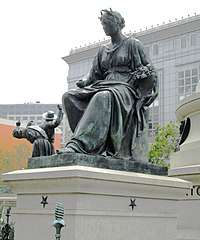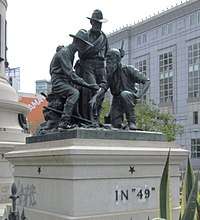Pioneer Monument (San Francisco)
The Pioneer Monument is a granite monument supporting bronze figures and bas reliefs created by Frank Happersberger and financed by the estate of James Lick. It is located on Fulton Street between Hyde and Larkin Streets in the Civic Center, of San Francisco, California. It was dedicated on November 29, 1894.[1]
The monument in 2013 | |
| Location | Fulton Street between Hyde and Larkin Streets Civic Center, San Francisco, California |
|---|---|
| Designer | Frank Happersberger |
| Completion date | 1894 |
Description
The monument consists of a large female figure of Minerva (Roman) or Athena (Greek), the goddess of wisdom and war, representing California on a column with four bronze reliefs representing "Crossing the Sierra," "Vaqueros Lassoing a Bull, "Trapper Trading Skins with Indians," and "California's Progress under American Rule", as well as portrait medallions of important personages in California's past, Sir Francis Drake, John Sutter, John Fremont, Father Junipero Serra, and the monument's benefactor, James Lick.
There are four piers surrounding the base of the column, supporting sculptures. Two are female figures allegorically representing Commerce and Plenty, and two are groupings of three figures each. One of these is titled "In '49'", commemorating the California Gold Rush, containing three gold miners.[2] The other, which was entitled "Early Days" and contained a missionary, a Native American, and a vaquero, was removed in September 2018 due to complaints that it was dehumanizing to Native Americans.[3]
History
The trustees of the Lick estate were tasked with implementing the thirteenth clause of the Lick trust which read as follows:[4]
"And in further trust to erect, under the supervision of said parties of the second part, and their successors, at the City Hall, in the City and County of San Francisco, a group of bronze statuary, well worth one hundred thousand dollars ($100,000), which should represent by appropriate designs and figures the history of California: First, from the early settlement of the missions to the acquisition of California by the United States; second, from such acquisition by the United States to the time when agriculture became the leading interest of the State; third, from the last-named period to the first day of January, one thousand eight hundred and seventy-four."
In September 1890, the Trustees selected the a model by sculptor Frank Happersberger from a field of four artist submissions.[4] Ground was broken in May 1894 at San Francisco City Hall.[5] The cornerstone of the monument was laid and statuary dedicated on Monday, September 10, 1894 by the Lick Trustees, Society of California Pioneers and Native Sons of the Golden West[6] at Marshall Square, near the intersection of Hyde and Grove, in front of the Old City Hall (which was later destroyed by the earthquake of 1906).[7]
In 1991, a plan was introduced to move the statue to make way for a new public library.[8] At the time, the statue was surrounded by a parking lot, seedy pornographic theaters and fast-food restaurants along Market Street.[8] This plan generated controversy between preservationists, who wanted the statue to remain in place to mark the site of Old City Hall, and Native American protestors who wanted the statue removed entirely.[8] The Native American protestors criticized the Early Days sculpture for depicting their people as subservient, for celebrating their subjugation,[9] and for factual inaccuracy—it depicts a Plains Indian none of whom lived near what would become San Francisco.[3] Early Days was removed on 14 September 2018, in early morning darkness.[3][10]
In 1991, twenty heavy-duty steel carrying beams were used to transport the statue one block and place it in the middle of Fulton Street, where it currently stands between the old and new libraries and across a park from the City Hall.[8] A brass plaque was added to the statue in 1996 to explain the role of Native Americans in California.[8]
Gallery
- South pier: Commerce
 North pier: Plenty
North pier: Plenty West pier: In "49"
West pier: In "49" East pier: Early Days, which was removed in September 2018.
East pier: Early Days, which was removed in September 2018.
References
- Radford, Warren and Radford, Georgia (2002) Outdoor Sculpture in San Francisco: A Heritage of Public Art, Gualala, California: Helsham Press. p.38
- "The Pioneers Monument (sculpture)". Art Inventories Catalog. Smithsonian American Art Museum.
- Fermoso, Jose (2018-09-24). "A 124-year-old statue reviled by Native Americans – and how it came down". the Guardian. Retrieved 2018-09-24.
- "THE LICK STATUARY The Design by Frank Happersberger Is Selected". California Digital Newspaper Collection, cdnc.ucr.edu. Daily Alta California. 13 September 1890. Retrieved 2016-06-11.
- "San Francisco Call 25 May 1894 — California Digital Newspaper Collection". cdnc.ucr.edu. Retrieved 2016-06-11.
- San Francisco Municipal Reports. order of the Board of Supervisors. 1894-01-01.
- "Civic Center – Pioneer Monument". Public Art and Architecture from Around the World. Retrieved 9 June 2016.
- Ybarra, Michael J. (7 May 1993). "San Francisco Journal;A Monument Caught in the Middle". The New York Times. Retrieved 9 June 2016.
- Todd, Gail (March 15, 2012). "Civic Center: A blend of all things San Francisco". San Francisco Chronicle. Retrieved July 17, 2013.
- Fracassa, Dominic (14 September 2018). "SF's controversial 'Early Days' statue taken down before sunrise". San Francisco Chronicle. Archived from the original on 14 September 2018. Retrieved 24 September 2018.
External links
